
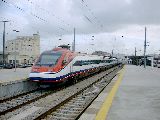
|
Porto
A Portuguese holiday started with a ride on a tilting train (left) from Lisboa to Porto. At the central station there - Sao Bento - we found this 1400 class diesel locomotive ready to depart on a train up the Duoro valley. The loco was manufactured in Newton-le-Willows, about ten miles from my home!
|

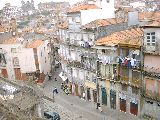
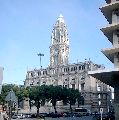
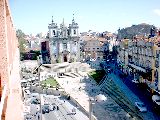
|
Porto's centre includes a lot of ramshackle-looking housing in very narrow streets.
This church (left) is in the view from our hotel balcony, and that's the town hall (I think) on the right.
|


|
British visitors may find one or two strangely familiar sights in the streets.
|
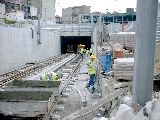

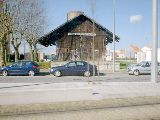
|
When I visited Porto Trindade station in 1998 it was the terminal for narrow gauge services to the north and I took a ride on a diesel train to Custoias. The station and the railway have now been transformed, with brand new standard gauge (1435mm) trams running partly along the old route and then on into the streets of northern Porto. Work is underway (right) to extend the line in the other direction under central Porto.
Very little evidence of the old system remains, except for the station building and this traditional goods shed at Senhora da Hora.
|
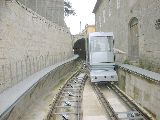
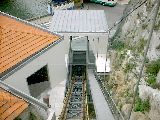
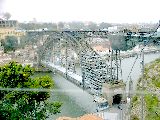
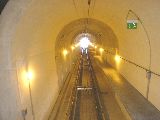
|
This funicular up the steep river bank (All of Porto seems to be steep hills!) has been very recently rebuilt and extended so that at the top it levels off and then runs in a tunnel under the streets to an interchange with a tram line (which is not yet operating). It provides an impressive view of one of Eifel's bridges. |
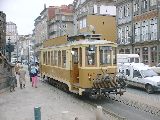
|
As well as the brand new trams shown above, there are a couple of routes in the city operated by "museum" vehicles like this.
|
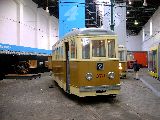
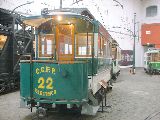
|
We used them to take us to the excellent tram museum, where they have an impressive collection of historic trams.
|
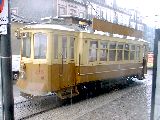

|
Also at the museum is the running shed where they have plenty of vehicles to run their current services. We took a different route back to the town centre in heavy rain.
|

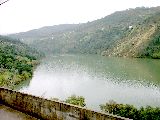
|
We took a ride westwards along the scenic Duoro valley to Tua, hauled by another Class 1400 loco (This one was made in Portugal under licence.)
|
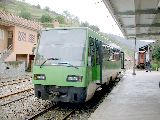
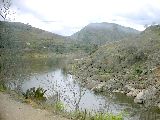
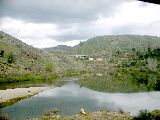
|
At Tua we changed to this metre gauge railbus to take us up the very scenic line to Mirandella.
|
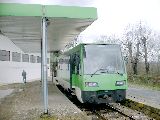
|
I had expected to find a pretty village because that's what you usually get at the end of a scenic branch line, but Mirandella is a sizeable industrial town. It had its own transport system, the Mirandella Metro, which turned out to be an identical railbus running a short distance from the town centre to its outskirts. My Portuguese is very limited but the timetable seemed to indicate that it only operated on Fridays! Luckily, it was Friday so we got our ride.
|
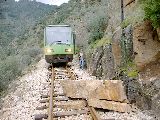
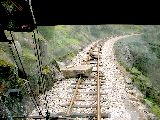
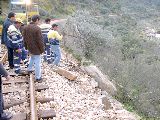

|
We took the train back towards Tua and we were nearly there when the driver shouted something and slammed on the brakes, stopping short of a large piece of rock which had fallen from beside the line. So, we did what all good railway enthusiasts would do in such a situation, and jumped off to take a picture.
We tried to shift the slab of rock but it was much too heavy, so we had to wait for the cavalry to arrive, in the form of a track maintenance crew from Tua. Their mechanical digger soon shifted the stone, and crowbars tipped it over the side. After less than an hour's delay we were on our way again.
|
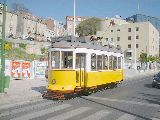
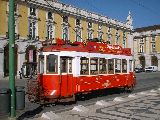
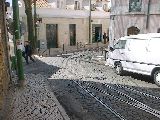
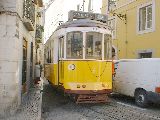
|
Lisboa
For part two of the holiday we moved on to Lisboa. Special trams (left) provide an expensive sight-seeing ride for tourists, but we chose instead an ordinary tram route, also run by ancient metre gauge trams (right).
This took us on an exciting ride along very narrow streets with interleaved track necessary to get round the tight corners.
|
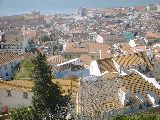
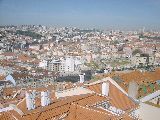
|
Next, up to the Castelo de S. Jorge for some fine views over the city.
|

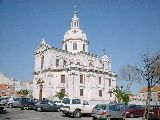
|
And then a wander round to look at a few of the impressive buildings.
|
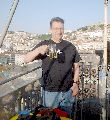

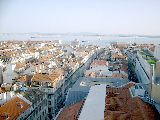
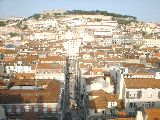
|
One way of avoiding climbing up the steep hills in the city is this splendid Victorian lift. At the top we found a bar, and more views of the city.
In the bottom left picture you can see the castle we visited earlier on top of the next hill.
|
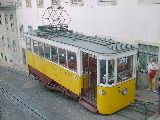
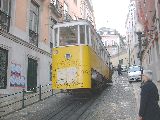
|
Another easy way up hill is to use one of the city's three funiculars. This one is called Elevator Gloria.
|

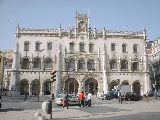
|
One of Lisboa's railway termini is at Rossio, which has an impressive frontage. Once in the doors you go up three flights of escalators before you reach the platforms.
|
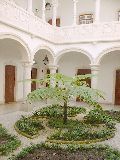
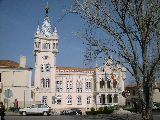
|
Sintra
A short train ride from Lisboa Rossio took us to the fascinating town of Sintra. We started our exploration at the town hall, with its enclosed courtyard.
|
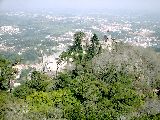

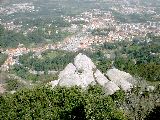
|
High on a mountain above the town is the Moorish Castle. We wandered along the battlements which wind up and down the hillside, and provide superb views of the town below and the plain beyond. In the centre of the lower picture you can see the railway station - thank goodness there was a bus up the hill!
|
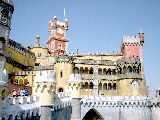


|
At the top of the next peak along is the spectacular Palácio Nacional da Pena. "The supreme expression of the romantic taste of Prince Ferdinand II, construction began in 1846." says the guide book, but as we explored the chaotic collection of gateways, battlements and turrets I couldn't help looking for the Disney logo. The royal rooms inside are also splendidly over the top but photography was not allowed.
|
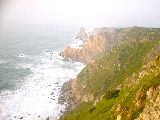


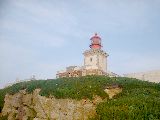
|
Next, we took a short bus ride to Cabo da Roca, where a monument and a lighthouse mark the westernmost point in mainland Europe. At this time of year, the sunset is almost exactly due west. I also seized the opportunity to have a drink in the westernmost bar in mainland Europe!
(Quite a bit of Eire is further west than this, including the towns of Killarney and Tralee.)
|
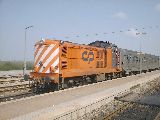

|
Algarve
Our train from Lisboa to the southern coast was three carriages hauled by one of these French 1900 Class locomotives (left) and we found most trains along the Algarve coast to be hauled by 1900s or 1400s (right).
|

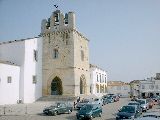


|
In the town of Faro we found this cathedral with a very ornate interior. The shrine (bottom right) is built of human bones.
|
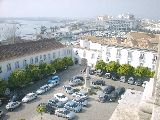
|
The tower provided a good view of the old town and marina.
|
































































